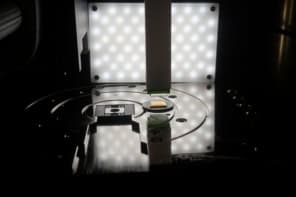
Researchers in Italy have created the first integrated circuit to combine two transistors made from the “wonder material” graphene. By adapting a technique used to fabricate silicon transistors the team created the device and then showed that it was capable of performing basic computational tasks. The innovation represents an important step in the pursuit of carbon-based electronics, say the researchers.
“This opens a way for the fabrication of more complex integrated circuits on graphene, which may replace silicon chips once silicon technology reaches its limits,” said Roman Sordan, one of the researchers at the Politecnico di Milano.
To push the boundaries of computing power further, we will need microscale electronics that performs simple logic tasks at ever faster speeds. With conventional silicon chips, the limiting factor is the carrier mobility, which is a measure of ease at which its electrons travel through the material.
Roadmap to high speed electronics
Graphene — the one-atom-thick sheet of carbon discovered in 2004 — may overcome this problem with the help of its unique electronic properties. Unsurpassed mobility and carrier velocities mean that graphene should be able to operate at much higher frequencies than conventional electronics.
In 2007 physicists in the US created the world’s first prototype graphene transistor by fabricating nanoscale electrodes next to the surface of graphene to create a p-n junction. Since then researchers have continued to seek ways in which to increase the speed of graphene transistors. This latest development represents the next step towards an operational graphene circuit — combining multiple transistors.
The researchers first isolated an amount of graphene from a sheet of carbon using mechanical exfoliation — basically, “sticky tape” — before depositing these onto a silicon substrate. Then, using high resolution electron beam lithography, the researchers fabricated two p-type transistors on the same flake on graphene.
It’s all logical
The next step was to create an “inverter” by joining up a type p transistor with a type n. They passed an electric current through one of the transistors and used the heating effect to remove contaminants — this converted one of type p transistors to type n.
To demonstrate that they had created a very simple computing device the researchers used the “circuit” to perform the simple logic task of Boolean inversion.
“It is good that someone has finally taken the initiative to build basic circuits with graphene,” said Tomas Palacios, an electrical engineering researcher at Massachusetts Institute for Technology (MIT).
Other researchers are not so impressed by the latest development. Yu-Ming Lin, a nano-scale applications researcher at the IBM T.J. Watson Research Center in New York feels that this fledgling graphene circuit needs substantial development before it can serve any practical purpose.
“While inverter is the critical component in any digital circuits, one important aspect of an inverter is the gain, which must be larger than unity to be of useful,” he said. The research was published on the arXiv preprint server.



